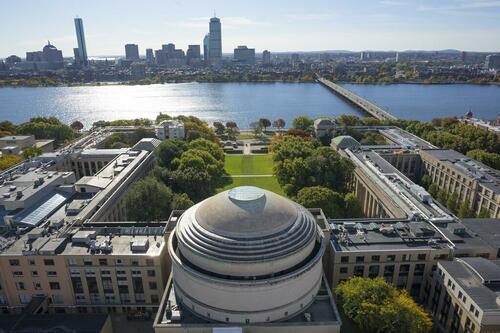
С Merit Back At The Fore, Black Enrollment Plummets MIT, азиатские скачки акций
Состав нового класса первокурсников Массачусетского технологического института ярко отражает эффект решения Верховного суда от 2023 года о запрете позитивных действий. — с долей пятен, отданных чернокожим, резко снизилась, в то время как азиатская регистрация подскочила. «Каждый студент, принятый в класс 2028 года в Массачусетском технологическом институте, будет знать, что они были приняты только на основе их выдающихся академических и внеклассных достижений, а не цвета их кожи», - сказал Эдвард Блум, который основал группу «Студенты за справедливый прием», которая победила в деле Верховного суда. Нью-Йорк Таймс.
 Массачусетский технологический институт, альма-матер конгрессмена из Кентукки Томаса Масси, выходит на реку Чарльз в Бостоне
Массачусетский технологический институт, альма-матер конгрессмена из Кентукки Томаса Масси, выходит на реку Чарльз в БостонеКласс Массачусетского технологического института 2028 года составляет всего 5% черных По сравнению с 15% для класса 2027 года. Латиноамериканцы и латиноамериканцы составляют 11%, по сравнению с 16%. Доля белых снизилась на процентный пункт — с 38% до 37%. Как и ожидалось, Главными победителями стали азиатские кандидаты, которые, несмотря на то, что сами являются меньшинствами, подвергались насилию со стороны режима позитивных действий.. Азиаты составляют 47% нового класса, по сравнению с 40%. (Цифры не составляют 100% из-за студентов, чье наследие охватывает более одной группы).
Разговаривая с ВремяПрезидент Массачусетского технологического института Салли Корнблут описала класс 2028 года с нотами скорби:
«Класс, как всегда, отличается разнообразием измерений. Как следствие прошлогоднего решения Верховного суда, это не приводит к такой же степени широкого расового и этнического разнообразия. Что сообщество MIT работало вместе, чтобы достичь за последние несколько десятилетий. "
Другими словами, если бы Корнблут смогла добиться своего, в классе первокурсников Массачусетского технологического института было бы не так много азиатов - заслуги будут прокляты.
 Члены азиатско-американской коалиции за образование выступили в Верховном суде США (Кент Нишимура/Los Angeles Times)
Члены азиатско-американской коалиции за образование выступили в Верховном суде США (Кент Нишимура/Los Angeles Times)MIT является первым крупным университетом, который публикует демографические данные о своем вступлении в класс, поэтому в ближайшие дни и недели будет больше обуви. Цифры MIT будут служить ориентиром Если другие университеты проявят гораздо меньшие изменения, они столкнутся с обвинениями в том, что они находят другие способы дискриминировать азиатов в пользу чернокожих и латиноамериканцев, а также, возможно, с судебными разбирательствами.
По решению Верховного суда, Сторонники фальсифицированных признаний ухватились за язык в решении, которое, казалось, оставило заднюю дверь открытой. Для учета расы в соображениях принятия. Суд постановил, что заявители по-прежнему могут свободно привлекать внимание к своей расе, если они делают это в контексте описания своего жизненного опыта, такого как борьба с дискриминацией.
Многие высоко избирательные школы подскочили под этот угол.. Заявка Джона Хопкинса, например, просит заявителей «рассказать нам об аспекте вашей личности (например, расе, полу, сексуальности, религии, сообществе и т. Д.) или жизненном опыте, который сформировал вас как личность». «Какие перспективы, сформированные вашим опытом, воспитанием и / или расовой идентичностью, вдохновляют вас присоединиться к нашему сообществу агентов изменений в Райсе?» Чтобы побудить заявителей подчеркнуть свою расу, Сара Лоуренс даже ссылается на решение Верховного суда в заявке на эссе. Нью-Йорк пост Сообщено.
Одобряете или не одобряете решение Верховного суда о принятии положительного решения?
Белый: 65% одобряют, 23% не одобряют
Латиноамериканцы: 45%-30%
Чернокожие: 43%-36%
Оба пола, все расы, каждая возрастная группа, каждый уровень дохода. Все они отвергают расовое управление. https://t.co/a74PiCnGBh pic.twitter.com/VF2qDVBZ0p
— Richard Hanania (@RichardHanania) 9 июля 2023 г.
MIT, однако, кажется исключением. Экономист Дьюка Питер Арчидиаконо, который служил в качестве эксперта-свидетеля для студентов за справедливый прием, сказал: Время Он сказал, что был приятно удивлен, когда пришел к выводу, что MIT не выбрал новый способ сфальсифицировать игру против азиатов. Судя по всему, MIT просто вывел расу из уравнения. Он сказал.
Однако, по крайней мере, один наблюдатель, управляемый данными, считает, что даже 5% черной доли новейшего класса MIT указывает на какое-то вмешательство от их имени:
По мере того, как начинают поступать данные о зачислении в класс первокурсников, учитывайте эти данные, чтобы, когда вы увидите, что чернокожие составляют 5% класса в высокоселективной школе (как и в MIT), вы поняли, что эти школы все еще участвуют в позитивных действиях. pic.twitter.com/GytDbJhv77
— i/o (@eyeslasho) 21 августа 2024 г.
Наконец, вот некоторые дополнительные атрибуты класса MIT 2028:
- Самые популярные имена — Эрик и София.
- Самым представительным штатом США является Калифорния
- 11% из зарубежных стран
- 3% имеют иную гендерную идентичность, чем мужчина или женщина.
- 67% окончили государственные школы; менее 1% получили домашнее образование.
- Уровень поступления в школу составляет около 5%
Тайлер Дерден
Thu, 08/22/2024 - 14:55












